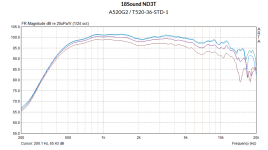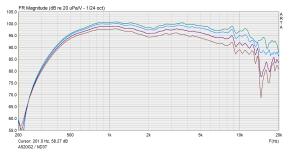Peerless 2535 is the one 😉 But oh, that ND3T is also tempting… If only measurements could predict the way it sounds 🙁
If you ever decide you have time for a 800-20k attempt I will sure buy the kit as well.
If you ever decide you have time for a 800-20k attempt I will sure buy the kit as well.
I'm reposting ND3T with the standard adapter from post https://www.diyaudio.com/community/...-design-the-easy-way-ath4.338806/post-7814257

And ND3T with the ND3N throat section optimized later adapter from post https://www.diyaudio.com/community/...-design-the-easy-way-ath4.338806/post-7815139

for easier comparison. The latter looks more orderly, but both start deviqting about at same frrquency so not sure if sound actually differs, need to test. Top of my mind is, how identifiable the on-axis is audibly, and I'd pick the one whose on-axis is not identifiable to ear, at least thats the ideal, not sure if it is possible.
What are the axis by the way? 10deg steps so 0-30?

And ND3T with the ND3N throat section optimized later adapter from post https://www.diyaudio.com/community/...-design-the-easy-way-ath4.338806/post-7815139

for easier comparison. The latter looks more orderly, but both start deviqting about at same frrquency so not sure if sound actually differs, need to test. Top of my mind is, how identifiable the on-axis is audibly, and I'd pick the one whose on-axis is not identifiable to ear, at least thats the ideal, not sure if it is possible.
What are the axis by the way? 10deg steps so 0-30?
Last edited:
I have also some very very quick measurements/comparison of ROSSO 65CDN-T and BMS 4554 with a basic adapter of 33.1 deg angle.
(I didn't have the right bolts so this was only put loosely on a stool.)
A520G2 waveguide, everything same for both.
(65CDN-T = red)

BMS 4554 alone:

Here you have a driver reaching 20 kHz with ease. Not so much at the lower end though.

(I didn't have the right bolts so this was only put loosely on a stool.)
A520G2 waveguide, everything same for both.
(65CDN-T = red)
BMS 4554 alone:
Here you have a driver reaching 20 kHz with ease. Not so much at the lower end though.
Last edited:
Something like that. I don't do any accurate polar measurements - there hasn't been the need so far.What are the axis by the way? 10deg steps so 0-30?
Hi mabat,
Perhaps not yet, but you are getting Close to the Edge (with attribution to Yes.).
Kindest regards,
M
I'm not a magician 🙂
Perhaps not yet, but you are getting Close to the Edge (with attribution to Yes.).
Kindest regards,
M
I'm trying to recall whether I've seen a measurement of a driver with 3" (or larger) diaphragm working considerably better than the ND3T shown. (That's not to say this is good, I'm just interested if there are significantly better drivers.) I'm sure such drivers are being used a lot, but there seems so few raw measurements actually available. Is there anything significantly better with a 3" diaphragm?
Now I've recalled this, but it's an old driver : https://www.diyaudio.com/community/...-design-the-easy-way-ath4.338806/post-7437739
And that's a 4" Ti diaphragm. I can try a Gen2 adapter...
And that's a 4" Ti diaphragm. I can try a Gen2 adapter...
RCF has quite a selection, for example 950 has 1.4" exit and 4" diaphragm https://www.rcf.it/en/products/product-detail/nd950-1.4
edit. they have new NDX and NDT drivers I haven't bumped before, like this 1" device: https://www.rcf.it/en/products/product-detail/ndx595
Or this NDT895 https://www.rcf.it/en/products/product-detail/ndt895
Responses they've published look good

edit. they have new NDX and NDT drivers I haven't bumped before, like this 1" device: https://www.rcf.it/en/products/product-detail/ndx595
Or this NDT895 https://www.rcf.it/en/products/product-detail/ndt895
Responses they've published look good

That's exactly the measurement that tells you almost nothing 🙂
Depending on the quality of the output wavefront, it can collapse off axis pretty quickly. On-axis is virtually irrelevant.
BTW, I have the NDX595: https://at-horns.eu/gen2m.html#ndx595
Depending on the quality of the output wavefront, it can collapse off axis pretty quickly. On-axis is virtually irrelevant.
BTW, I have the NDX595: https://at-horns.eu/gen2m.html#ndx595
It's not bad. Here with an extended throat:

Or this: https://www.diyaudio.com/community/...-design-the-easy-way-ath4.338806/post-7723482
It sounded a bit harsh at first, but then I didn't pursue it further, maybe it could be EQed out. Probably.
I liked the DF10.171K better, that's also a very nice 1" driver:

Or this: https://www.diyaudio.com/community/...-design-the-easy-way-ath4.338806/post-7723482
It sounded a bit harsh at first, but then I didn't pursue it further, maybe it could be EQed out. Probably.
I liked the DF10.171K better, that's also a very nice 1" driver:
Last edited:
Updating this thing with taps located on the "knuckles" in the hopes that moving them from a high impedance area of the profile to a low impedance area will result in less disruption of the CD wavefront and maybe a measured polar response that is more consistent with the simulation.


Doing this increased the path lengths of the taps, resulting in more volume of air in the bandpass chambers. To counteract the effect this would have (it would shift the woofers' rolloff lower), I'm integrating cone fillers.

Right now I'm debating on whether I should keep the tap "straight" or angle it so that the entrance is located central to the cone. I've gotten good feedback from others on the pros/cons of this, but it seems to all boil down to:
1. Moving the tap entrance to the middle of the cone will result in more equal loading of the cone, meaning less stress/risk of tearing, and less cone deformation - possibly resulting in less nonlinearities (distortion). Because of this, I can safely bump up the compression ratio and make the exit area of the tap even smaller, resulting in even less CD wavefront disruption.
2. Keeping the tap straight and at the edge of the cone means that there are unequal path lengths that the sound has to travel from one edge of the cone versus the other (see sketch lines in above screenshot). This will result in cancellations once the wavelengths become short enough in relation to the cone diameter. However, in MEHs this is a feature not a bug, as that's the mechanism by which the taps provide an acoustic lowpass filter that removes unwanted distortion above the XO frequency.
I think the move at this point is to make a test baffle to compare tap placement at the edge of the cone versus centrally located.
Doing this increased the path lengths of the taps, resulting in more volume of air in the bandpass chambers. To counteract the effect this would have (it would shift the woofers' rolloff lower), I'm integrating cone fillers.
Right now I'm debating on whether I should keep the tap "straight" or angle it so that the entrance is located central to the cone. I've gotten good feedback from others on the pros/cons of this, but it seems to all boil down to:
1. Moving the tap entrance to the middle of the cone will result in more equal loading of the cone, meaning less stress/risk of tearing, and less cone deformation - possibly resulting in less nonlinearities (distortion). Because of this, I can safely bump up the compression ratio and make the exit area of the tap even smaller, resulting in even less CD wavefront disruption.
2. Keeping the tap straight and at the edge of the cone means that there are unequal path lengths that the sound has to travel from one edge of the cone versus the other (see sketch lines in above screenshot). This will result in cancellations once the wavelengths become short enough in relation to the cone diameter. However, in MEHs this is a feature not a bug, as that's the mechanism by which the taps provide an acoustic lowpass filter that removes unwanted distortion above the XO frequency.
I think the move at this point is to make a test baffle to compare tap placement at the edge of the cone versus centrally located.
I think even with cone filler the low pass filtering is the result of chamber and tap (port), thus a bandpass/helmholtz resonator effect.that's the mechanism by which the taps provide an acoustic lowpass filter that removes unwanted distortion above the XO frequency.
Can be simulated in hornresp with driver chamber.
That's one thing I'm still a little unclear on to be honest. Because it looks like hornresp simulates the tap in the center of the cone as there's nothing I'm telling it to indicate the tap being at the edge of the cone, meaning the low pass is a result of what you describe being a bandpass/helmholtz resonator effect. So maybe the cone filler creating unequal path lengths isn't really a major factor.
Either way, I think a test baffle to A/B would be good for me as a learning exercise regardless.
Either way, I think a test baffle to A/B would be good for me as a learning exercise regardless.
Exciting stuff!Doing this increased the path lengths of the taps, resulting in more volume of air in the bandpass chambers.
Will be interesting to see what your phase alignment delays in ms look like.
BMS 4554 extended, with an adapter starting right at the exit of the (ring) diaphragm, which is roughly ⌀16 mm.
Still keeping the directivity of Gen2, I think this is actually pretty cool.
Shaping the response is no issue with a DSP. Perhaps it could be further optimized in the adpater, hard to say.


(Measured with A520G2; at two different distances from the mouth.)

- Did a quick sweep for harmonics, at two different levels, just to have an idea:
2nd, 3rd, 4th:



Seems to me like 700 Hz would still be no problem.
Given the 4554 is available for around €135, this would be hard to beat, IMHO.
Still keeping the directivity of Gen2, I think this is actually pretty cool.
Shaping the response is no issue with a DSP. Perhaps it could be further optimized in the adpater, hard to say.
(Measured with A520G2; at two different distances from the mouth.)
- Did a quick sweep for harmonics, at two different levels, just to have an idea:
2nd, 3rd, 4th:
Seems to me like 700 Hz would still be no problem.
Given the 4554 is available for around €135, this would be hard to beat, IMHO.
Last edited:
- Home
- Loudspeakers
- Multi-Way
- Acoustic Horn Design – The Easy Way (Ath4)
